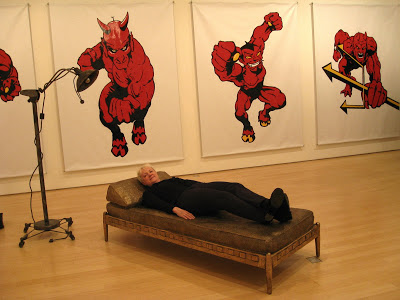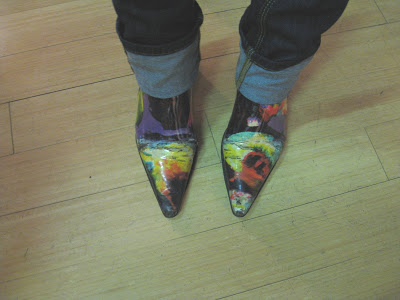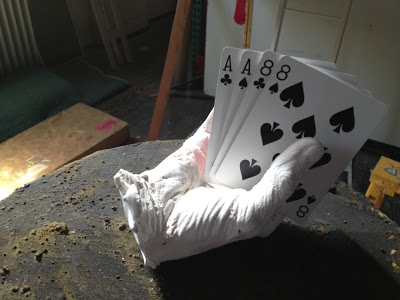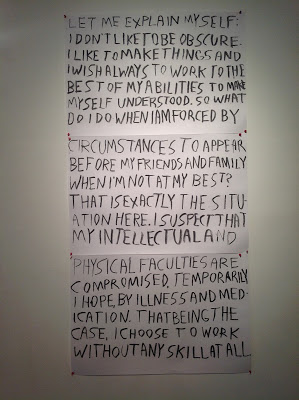Matt Freedman
Art Vent Letting the Fresh Air In
Update: And here, a detailed and eloquent review of the show by Thomas Mitchell.
HIGH:
Thursday night a bunch of us ran around like madmen in the rain to as many Chelsea openings as we could squeeze into the two-hour window. I wanted my socks knocked off but alas, they were not. (No doubt 21st century art will look very different from 20th century art, but no one seems to have figured it out yet.)
 William Blake at the Morgan Library
William Blake at the Morgan Library Friday, however, Roberto had the brilliant idea of spending the day, also rainy, at the Morgan Library where William Blake’s World: A New Heaven is Begun had just opened (runs through January 3rd). The exhibition is gorgeous, with wall text even I approve of: Blake’s poems and descriptions of his images. Fortunately there were few enough visitors that I could quietly speak the poems to myself, which is how I most enjoy poetry and its cadence. There were also illuminated medieval manuscripts from the collection, where the text follows the back story of a prayer book that was cut up and pieces sold, only to be discovered later and re-inserted into the original. Without Roberto’s prodding I would’ve skipped the show of acquisitions since 2004, small gems from various eras chosen with a discerning curatorial eye (or, no doubt “eyes” – the curators aren’t credited). Contemporary highlights were Mary Frank’s owl, a black presence with spread wings that hovers across the top of an otherwise blank white paper, a Jim Dine drawing of wrenches from 2000 that’s absolutely beautiful (I haven’t lost my mind, it really is), a sweet little James Siena and a small, stunning Stephen Antonakos painting of an interrupted red circle on a bright blue background—none of which I can post because, here again, photographs were prohibited, and there was no press material at the front desk (they said it was “too soon” for the Blake) nor anyone available to talk to.
We had a posh lunch in the paneled and high-ceilinged dining room (under the self-important gaze of Mr. Morgan’s portrait) where I enjoyed a tower of perfectly pan-seared rainbow trout, Nick had the Apre Fronte ravioli (whatever that is), and Roberto feasted delicately on the lunch special that was inspired by the medieval manuscript exhibition: tiny roasted legs of quail with a watercress and red grape salad and an aperitif of iced mead, which tasted of honey and flowers.
LOW:
I love it when artists do stuff just for the sake of doing it, and I’m actually happier crammed into a scruffy walk-up loft with 100 people drinking warm beer than in Mr. Morgan’s rarified dining room. So Friday night, still in the rain, I negotiated the long desolate streets of Long Island City to attend one of Matt Freedman’s projects, “Twin Twin III, Artists Edition” on the anniversary of the September 11th attacks.
Matt, an old friend, has a rumpled disarming manner and genuinely seems to think he doesn’t know anybody or do anything when, in fact, he knows everyone and is always working on a gazillion quirky projects, none of which—like the “Iron Artist” event he arranged at PS 1 in 2006—ever promises the remotest possibility of remuneration. Another friend, who he doesn’t know, described Matt as “a Williamsburg fixture” which I thought sounded too static. Matt suggested “dynamic presence” or “moving target” but said anything was fine as long as it wasn’t “local artist.”
The idea behind “Twin Twin” came from being so bombarded with images by the media after September 11th that anything that was long, narrow, rectangular and there were two of began to bear a creepy resemblance to the World Trade Center buildings. Previous shows consisted of a collection of everyday objects and pieces he’d modeled, but for this third iteration it seemed natural to Matt, whose projects are often contingent on the contributions of others, to open it up to 50 or so artist friends (my contribution was a pair of found champagne glasses gilded with “2001”). The result, as it was installed in Kate Teale's Big & Small/Casual Gallery (up for only three days), was a hodge-podge, darkly funny and unnerving.
Matt in a photograph from the 2006 Pierogi edition:
 And Kate’s niece, Rose, at the opening, inadvertently surrounded by many “twin towers.”
And Kate’s niece, Rose, at the opening, inadvertently surrounded by many “twin towers.” Photo by David Henderson
Photo by David Henderson
Afterward we went to have barbecue at a nearby bar where the cook alternately doled out dollar bills to make change and arranged spare ribs ($10) on paper plates without removing his latex gloves, and I had to protect my portion from the big dog that was under the table. The ribs were delicious.
IN-BETWEEN:
Saturday evening it was not raining (much), and I was back in the Berkshires for the opening of a group show, “The Great Impression,” at Geoffrey Young’s gallery in Great Barrington. Geoff is a writer, poet, publisher (poetry and art criticism, including anthologies by Jerry Saltz and Peter Schjeldahl), and onetime professor who has operated out of this small, second floor space for as long as I’ve been coming to the Berkshires. Open Thursday through Saturday five and a half months a year, it’s a real gallery, in the sense that Geoff actually does sell work, but it’s usually small and affordable, often unframed, tacked up on the wall. Also Geoff can be haphazard about his mailing list (if you get dropped off it, don’t take it personally) and updating his Web site (it’s current now, but last month when I was in one of his shows, a friend called and said, “The opening is Sunday, not Friday, and you’re not in it” to which I suggested she check the date—2008). But while Geoff is happy to do business, it’s not really the point—which is, as far as I can tell, to have a good time and stimulate intellectual foment in these bucolic parts. And that he does very well. He’s a master at mixing things up—well-known artists, such as Jim Shaw and James Siena, known and not-so-known area artists, and discoveries from New York and elsewhere. Where and how Geoff finds artists seems to be his secret, but his eye is sure, and with every show there’s at least one happy surprise. He opens his rambling art-filled Victorian home to the out-of-towners and everyone gathers there after dinner to play ping-pong and talk about art in a way that never seems to happen in the city.
For dinner we went downstairs on Railroad Street to Allium, a restaurant that doesn’t quite live up to its pretentions—or price—but the company made up for it. And I have to admit the maple pot de crème was amazing.
From the show:
 Cary Smith, New Graphite, Small Drawing #8, 2009, 12" x 11'
Cary Smith, New Graphite, Small Drawing #8, 2009, 12" x 11' Erick Johnson, Untitled (PP78). 2008, Gouache on paper, 8.5" x 11".
Erick Johnson, Untitled (PP78). 2008, Gouache on paper, 8.5" x 11".


 Matt Freedman, Lost Puppy, 2006.
Matt Freedman, Lost Puppy, 2006.  This is me, confronting my demons on the psychoanalytic couch that’s the centerpiece of Jude Tallichet’s show at Sara Meltzer. Cast in bronze and looking seductively comfy when it’s really hard—very hard—and scratchy, it’s the perfect metaphor. I’m not into back-stories, but that this is a replica of the couch from her late psychiatrist father-in-law’s office adds another poignant layer. I love Jude’s work because it’s conceptual yet meticulously rendered, as well as simultaneously deep and funny—like her. Also her friends have the best shoes. Here’s a little photo essay from Friday's opening:
This is me, confronting my demons on the psychoanalytic couch that’s the centerpiece of Jude Tallichet’s show at Sara Meltzer. Cast in bronze and looking seductively comfy when it’s really hard—very hard—and scratchy, it’s the perfect metaphor. I’m not into back-stories, but that this is a replica of the couch from her late psychiatrist father-in-law’s office adds another poignant layer. I love Jude’s work because it’s conceptual yet meticulously rendered, as well as simultaneously deep and funny—like her. Also her friends have the best shoes. Here’s a little photo essay from Friday's opening:









